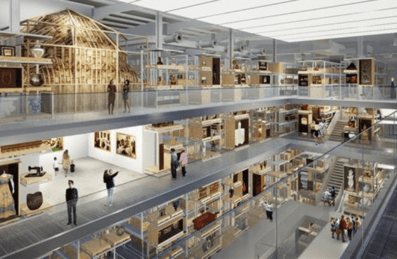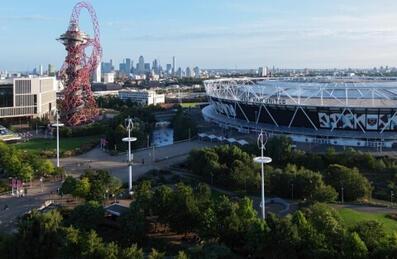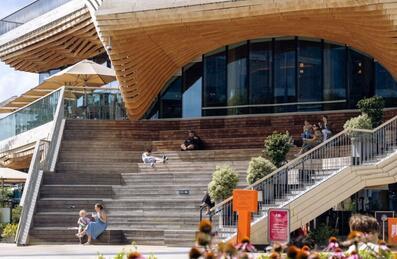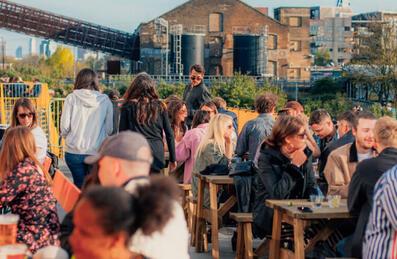
Popular Searches:
Keep up to date
Sign up today for exclusive offers and incredible experiences you won’t want to miss at Queen Elizabeth Olympic Park.
Sign up nowThe legacy of London 2012 has come to life at Queen Elizabeth Olympic Park
The legacy of London 2012 has come to life at Queen Elizabeth Olympic Park
Press Release 10/12/2018
Five years on a lot has changed and there's plenty still to come.
- The Park has been transformed into a great place to live, work and visit
- More than 16 million people have visited since the Games
- 40,000 jobs by 2025 and 24,000 new homes on and around the Park by 2031
- Development continues with the new Cultural and Education District bringing world-class institutions to east London
- Images can be found at http://www.2012imagelibrary.co.uk/library/token/760/c30444deb1e894d0a712d0a6dd591767d018548a
In the summer of 2017, the eyes of the world will once again be on the London Stadium at Queen Elizabeth Olympic Park when, for the first time ever, the World ParaAthletics Championships and the IAAF World Championships will be held in the same city in the same summer. Five years on from hosting the London 2012 Olympic and Paralympic Games, the former Olympic Park is ready to welcome back world-class athletes and spectators to be a part of the legacy that was such a huge focus of the London 2012 bid.David Goldstone, Chief Executive of the London Legacy Development Corporation, said: “So much has changed at Queen Elizabeth Olympic Park in the last five years. Since London 2012, homes have been built, thousands of jobs have been created and millions of people have visited the venues and events at the Park. And there's even more to come; from world class universities and museums to new schools and businesses."
London 2012
Following London’s successful bid to host the Games in 2005 a huge programme of clearing and cleaning took place in Stratford; 200 buildings were removed, 52 electricity pylons were taken away and 200 hectares of brownfield land, waterways, and rail lines were transformed. Wasteland made way for world class sports venues, and 17,000 athletes and officials from 204 nations were housed on the former home of Europe’s largest fridge mountain. In total, 14 temporary and permanent venues were built, 20km of new roads were added, 13km of new tunnels were created, 26 bridges were developed and 80 hectares of parkland was added to the site. At the heart of everything that was done was the legacy; in fact, 75p in every £1 that was spent for the Games, had legacy benefits, and the impact of this can be seen on the Park today.
Post-Games Transformation
For London, the Games were just the beginning. The closing ceremony of the Paralympic Games marked the start of a brand new chapter for the Park. An ambitious 18 month programme was undertaken by the London Legacy Development Corporation to transform the 560 acre site designed specifically to host four weeks of sport, into Queen Elizabeth Olympic Park – a new heart for east London and a destination for millions to live, work and visit.
All eight permanent venues underwent their own transformations to ensure they were suitable for both the local community and world class athletes. The temporary seating wings at the London Aquatics Centre were removed, brand new BMX, road and mountain bike tracks were built at Lee Valley VeloPark, and a comprehensive programme at the London Stadium saw the installation of new lights, seating, and the world’s largest single cantilevered roof.
In July 2013, just one year after the Games, the north of the Park reopened with new playgrounds and café’s as well as beautiful parklands to explore. Just nine months later in April 2014, the south of the Park reopened, and where once paved pathways dominated, there are now landscaped gardens and adventure playgrounds for people to enjoy.
Today
Today the Park is open 24 hours, entry is free and over 16 million people have already enjoyed the parklands, venues and events. Tens of thousands of people have enjoyed large scale concerts and sporting events in the venues as well as community focussed local events.
With membership prices the same as those at other leisure centres across east London, the venues are accessible to the whole community and well used by local people. Over 2.5 miilion people have made a splash at the London Aquatics Centre (LAC), which also teaches 1,400 school children a week to swim, 2 million have enjoyed the Lee Valley VeloPark, and 1.5 million people have visited the Copper Box Arena (CBA). The Slide at the ArcelorMittal Orbit regularly sells out during school holidays and has received rave reviews as one of the best activities in London despite only just celebrating its first birthday.
The Stadium was the last venue to reopen. Even before transformation had been completed, the venue hosted a number of events including the Rugby World Cup 2015, international Rugby League, motorsport, and the Anniversary Games. It is now the national competition centre for UK Athletics and a new home for West Ham United Football Club, and has already hosted four hugely successful concerts this summer alone.
The Park’s commitment to a community sporting and Paralympic legacy continues to go from strength to strength. The Active People, Active Park programme has taken 260,300 free sporting opportunities out to the local community since 2014, and includes a dedicated £1.7 million programme, Motivate East, which has so far taken almost 90,000 free sporting opportunities to disabled people. As part of the Paralympic legacy, the Park has also supported the creation of the Global Disability Innovation Hub which brings together partners, local communities, academics, and disabled people to drive innovation, co-design, and think creatively.
And the Park is not just a place to visit, many people are now choosing to live and work here. East Village, the former Athletes’ Village, is fully occupied and residents have already moved into the Park’s first new neighbourhood, Chobham Manor, one of five to be built over the next decade. Work is also already underway on East Wick and Sweetwater, the next two neighbourhoods to be built and, in September 2016, Mossbourne Riverside Academy opened as the first new school at the Park. Here East, the former Press and Broadcast Centre, is fast becoming a space for innovation, education and enterprise and is home to a fantastic mix of tech, education and culture, with tenants such as BT Sport, Loughborough University London, Plexal, and Studio Wayne McGregor. Thousands of new jobs have been created at Here East as well as across the Park venues and through the construction work that has taken place, many of which have been filled by local people.
Following on from the Games, the Park also continues to ‘inspire a generation’, not just through the amazing venues and sports on offer but through its high accessibility and sustainability standards. Through these plans, the Park has already delivered innovations such as the multi-generational home, the largest free-to-access wifi network in an urban parkland, and recognition of the Park as a European Smart, Sustainable District.
The Future
And we’re not done yet! There will be 40,000 jobs on the Park by 2025 and 24,000 homes will be built on and around the Park by 2031. Development will continue with the new Cultural and Education District which will bring world-class institutions to east London and will include plans for new campuses for UCL (University College London) and UAL’s London College of Fashion as well as additional sites for the Victoria and Albert Museum, the Smithsonian, and Sadler’s Wells Theatre. International Quarter London is already underway with two new headquarters being built for the Financial Conduct Authority and Transport for London, and Westfield Stratford City continues its success with almost 50 million people passing through its doors every year.
-Ends-
For more information contact the Press Office at Queen Elizabeth Olympic Park on +44 (0) 20 3734 9010 or email press@QueenElizabethOlympicPark.co.uk
Notes to Editors
Spread across 560 acres of stunning parklands, Queen Elizabeth Olympic Park is home to beautifully landscaped gardens, historic waterways, famous sporting venues, a vibrant arts and events programme and the ArcelorMittal Orbit visitor attraction.
Queen Elizabeth Olympic Park opened in April 2014 following the 18 month transformation programme of the London 2012 Olympic Park. It is now home to six former Olympic and Paralympic venues, the Copper Box Arena, Lee Valley Hockey and Tennis Centre, Lee Valley VeloPark, London Aquatics Centre and London Stadium where visitors can take part in sport, enjoy watching world class athletes compete or experience concerts or arts and culture events. Visitors can also enjoy a birds-eye view of the Park from the two viewing platforms of the ArcelorMittal Orbit, the UK’s tallest sculpture, before experiencing an exhilarating ride on The Slide, the world’s tallest and longest tunnel slide.
As the new heart of east London, the Park is still transforming and will soon provide future homes, jobs and an unrivalled education and cultural district housing Sadler’s Wells, V&A East, UAL’s London College of Fashion and UCL East.
The London Legacy Development Corporation promotes and delivers physical, social, economic and environmental regeneration in Queen Elizabeth Olympic Park and the surrounding area by maximising the legacy of the London 2012 Olympic and Paralympic Games.
For more information visit our website (QueenElizabethOlympicPark.co.uk), sign up to our e-newsletter (QueenElizabethOlympicPark.co.uk/subscribe), follow us on Twitter (@noordinarypark) and like us on Facebook (facebook.com/QueenElizabethOlympicPark)






